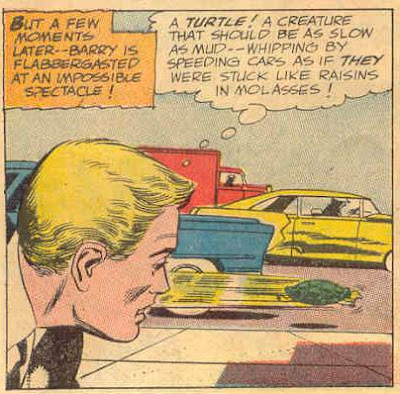Okay, so last night I was reading Forbidden Worlds #81, which includes a very interesting story:
The story has a very simple premise, most of which you can guess from the summary above. Amos is perpetually late (hello, Barry Allen!), but then he buys a gold pocketwatch to make sure he's on time. And suddenly something happens:
The entire world comes to a stop. And so did I, because I immediately recognized this story. It's
The Girl, the Gold Watch, and Everything, a famous novel by John MacDonald, the creator of Travis McGee, and a writer who's probably sold more novels than all but 20 people on the planet.
So I thought, well, it might make an interesting post to talk about how Richard Hughes, who wrote almost all of ACG's stories, copied MacDonald's novel, so I looked up
TGTGWAE on Wikipedia.
The Girl, the Gold Watch & Everything (1962) is a science fiction novel written by John D. MacDonald, considered "a classic screwball mystery".And I frowned, because I already sensed that Forbidden Worlds #81 was earlier than that, and sure enough, it turned out to be the August, 1959 issue.
My god, had one of the most famous writers ever cribbed a story from a comic book? And not just a story, but one according to WP which had 24 printings and been made into not one, but two TV movies? Well, it goes quite a bit deeper than that. The Wikipedia entry notes:
A similar plot line - a man stopping time - already appeared in 1955 in Roger Lee Vernon's story "The Stop Watch", included in the collection "The Space Frontiers". Vernon treated the theme far more seriously, with his protagonist using the device to commit crimes with impunity and win the Third World War all by himself, and finally suffering a terrible perdition.
So I googled Roger Lee Vernon Stop Watch and guess what came up? A
blog by the man himself where he had apparently posted the complete contents of The Space Frontiers. As you can see if you scroll down to the table of contents there is no story called
The Stop Watch, but there is one called
The Time Tablets, about a pharmaceutical chemist who invents a drug which stops time. It's a very, very cool story, and I highly recommend scrolling down and reading it.
But, at least compared to the Wikipedia entry it is not directly comparable to either
All the Time in the World or
The Girl, the Gold Watch and Everything. Same premise (stoppage of time), but lacking the watch angle. And the whole bit about him stopping WWIII was completely lacking in
The Time Tablets.
End of story? Not quite. You see, in my Googling, I learned of another story called
All the Time in the World, by Arthur C. Clarke, one of the most famous science fiction authors of all time. Among other stories, he wrote the novels that were turned into the movies of
2001 A Space Oddysey and
Fantastic Voyage. And that would be an easy place to close, but I Googled Clarke and All the Time in the World and found out that his story had been turned into an episode of a very early sci-fi TV series called Tales of Tomorrow. Not only that but you could watch that very
episode online here.
I really, really recommend you watch that episode; it's 1952 TV, it was apparently performed live (with set changes during commercial breaks) and it's terrific. As you can see, Clarke seems to be the father of all the "stopped time" stories. At least from what I can see, the originator of the watch to stop the clock is Hughes in Forbidden Worlds #81.
What I find more interesting for the purposes of this post is that Hughes' protagonist, Amos Dalrymple, unlike the characters in Clarke, Vernon, or MacDonald, decides to pass on the obvious pecuniary advantages of stopping time, because he is honest:
Instead he tries to make it to his date on time, but when he does he sees a problem:
Worse still, he learns that he cannot save her while time is stopped, because everything is frozen in time. He must do the only thing possible:
He shoves her out of the way of the bus. Thus he does not make a lot of money (although he is given a job by a bank president who had previously declined him a job due to him being late for the interview) but he does get what the characters in the two previous stories do not: the Girl. It's interesting to speculate more on the inspirations for MacDonald's best-seller. From what I can see, Hughes added the crucial element of the watch, which gets mentioned at the end of the ACG story:

But it is very obvious from the title that he was inspired by Clarke's short story. As for Vernon, I simply note two strange elements from his story. 1. At one point the protagonist's girlfriend says that she makes $20,000 a year more than he does. 2. The protagonist mentions that depositing more than $10,000 into a bank account draws the attention of the feds, who suspect drug dealing. Both of those points, despite numerous other markers, make me suspect that the Vernon story was updated for modern audiences from its initial 1950s publication.
Update: J.L. Bell in the comments points to
this short story by L. Frank Baum from the early 1900s as an even earlier example of the stopped time plot. Thanks! Update II: Here's an earlier example of a watch used to stop time, from Strange Adventures #50 (November 1954):
Thanks to an anonymous commenter!




















































